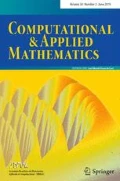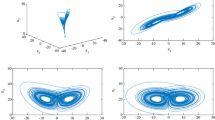Abstract
In this paper, we present the \( \psi \)-Hilfer fractional derivatives of variable order (FDVO) of 3 types I, II and III, versions A and B, as well as their combinations. In addition, we propose approximations and relations between both derivatives, i.e., \( \psi \)-Hilfer FDVO and \( \psi \)-Caputo FDVO. With regard to the \( \psi \)-Hilfer FDVO type II, we discuss the stability of the FVO nonlinear systems 7 solutions by means of one-parameter Mittag-Leffler functions of variable order. Examples 8 involving the FDVO Lü and Chen systems are also presented.






Similar content being viewed by others
References
Almeida R (2017a) Caputo–Hadamard fractional derivatives of variable order. Numer Funct Anal Opt 38(1):1–19
Almeida R (2017b) A Caputo fractional derivative of a function with respect to another function. Commun Nonlinear Sci Numer Simul 44:460–481
Almeida R, Torres Delfim F, M, (2015) A discrete method to solve fractional optimal control problems. Nonlinear Dyn 80.4:1811–1816
Almeida R, Nuno RO, Bastos Teresa M, Monteiro T (2016) Modeling some real phenomena by fractional differential equations. Math Methods Appl Sci 39.16:4846–4855
Almeida R, Nuno RO, Bastos Teresa M, Monteiro T (2018) A fractional Malthusian growth model with variable order using an optimization approach. Stat Opt Inf Comput 6.1:4–11
Almeida R, Tavares D, Torres Delfim FM (2019) The variable-order fractional calculus of variations. Springer briefs in applied sciences and technology. Springer, Cham
Atanackovic T, Janev M, Pilipovic S, Zorica D (2013) An expansion formula for fractional derivatives of variable order. Open Phys 11.10:1350–1360
de Oliveira EC, Sousa JVC (2018) Ulam–Hyers–Rassias stability for a class of fractional integro-differential equations. Results Math 73(3):111
Debnath L (2004) A brief historical introduction to fractional calculus. Int J Math Educ Sci Technol 35(4):487–501
Hajipour M, Jajarmi A, Baleanu D, Sun H (2019) On an accurate discretization of a variable-order fractional reaction–diffusion equation. Commun Nonlinear Sci Numer Simul 69:119–133
Herzallah MAE, Baleanu D (2009) Fractional-order Euler–Lagrange equations and formulation of Hamiltonian equations. Nonlinear Dyn 58(1–2):385
Karniadakis GE (2019) Handbook of fractional calculus with applications. Numerical methods, vol 3. De Gruyter, Berlin
Leibniz GW (1849) Letter from Hanover, Germany, to GFA L’Hopital, September 30; 1695. Math Schr 2:301–302
Leibniz GW (1962a) Letter from Hanover, Germany to Johann Bernoulli, December 28, 1695. Leibniz Mathematische Schriften. Olms-Verlag, Hildesheim, p 226
Leibniz GW (1962b) Letter from Hanover, Germany to John Wallis, May 28, 1697. Leibniz Mathematische Schriften. Olms-Verlag, Hildesheim, p 25
Li C, Chen G (2004) Chaos in the fractional order Chen system and its control. Chaos Solitons Fract 22(3):549–554
Lu JG (2006) Chaotic dynamics of the fractional-order Lü system and its synchronization. Phys Lett A 354(4):305–311
Machado JA, Tenreiro V Kiryakova, Mainardi F (2011) Recent history of fractional calculus. Commun Nonlinear Sci Numer Simul 16.3:1140–1153
Nash JF, Rassias MT (2016) Open problems in mathematics. Springer, New York
Odzijewicz T, Malinowska A, Torres D (2013) Noether’s theorem for fractional variational problems of variable order. Open Phys 11(6):691–701
Oliveira DS, de Oliveira EC (2018) Hilfer–Katugampola fractional derivatives. Comput Appl Math 37.3:3672–3690
Polya G, Kilpatrick J (2013) The Stanford mathematics problem book: with hints and solutions. Courier Corporation, Chelmsford
Pooseh S, Almeida R, Torres DFM (2012) Expansion formulas in terms of integer-order derivatives for the Hadamard fractional integral and derivative. Numer Funct Anal Opt 33(3):301–319
Pooseh S, Almeida R, Torres DFM (2013) Numerical approximations of fractional derivatives with applications. Asian J Control 15(3):698–712
Samko S (2013) Fractional integration and differentiation of variable order: an overview. Nonlinear Dyn 71(4):653–662
Samko SG, Ross B (1993) Integration and differentiation to a variable fractional order. Int Transf Spec Funct 1.4:277–300
Samko SG, Kilbas AA, Marichev OI (1993) Fractional integrals and derivatives, vol 1. Gordon and Breach Science Publishers, Yverdon-Les-Bains
Sierociuk D, Malesza W, Macias M (2013) On a new definition of fractional variable-order derivative. In: Proceedings of the 14th international Carpathian control conference (ICCC). IEEE
Sierociuk D, Malesza W, Macias M (2015) Derivation, interpretation, and analog modelling of fractional variable order derivative definition. Appl Math Model 39(13):3876–3888
Sierociuk D, Malesza W, Macias M (2016) On a new symmetric fractional variable order derivative. In: Domek S, Dworak P (eds) Theoretical developments and applications of non-integer order systems. Springer, Cham, Heidelberg, pp 29–40
Sousa JVC, de Oliveira EC (2018a) On the \(\psi \)-Hilfer fractional derivative. Commun Nonlinear Sci Numer Simul 60:72–91
Sousa JVC, de Oliveira EC (2018b) Ulam–Hyers stability of a nonlinear fractional Volterra integro-differential equation. Appl Math Lett 81:50–56
Sousa JVC, de Oliveira EC (2018c) Two new fractional derivatives of variable order with non-singular kernel and fractional differential equation. Comput Appl Math 37(4):5375–5394
Sousa JVC, de Oliveira EC (2019a) Leibniz type rule: \(\psi \)-Hilfer fractional operator. Commun Nonlinear Sci Numer Simul 77:305–311
Sousa JVC, de Oliveira EC (2019b) On the \(\Psi \)-fractional integral and applications. Comput Appl Math 38.1:4
Sousa JVC, de Oliveira EC, Magna LA (2017) Fractional calculus and the ESR test. AIMS Math 2(4):692–705
Sousa JVC, Santos MNN, Magna LA, de Oliveira EC (2018) Validation of a fractional model for erythrocyte sedimentation rate. Comput Appl Math 37.5:6903–6919
Sousa JVC, Kucche KD, de Oliveira EC (2019) Stability of \(\psi \)-Hilfer impulsive fractional differential equations. Appl Math Lett 88:73–80
Sun H, Chen W, Chen Y (2009) Variable-order fractional differential operators in anomalous diffusion modeling. Phys A Stat Mech Appl 388(21):4586–4592
Sun H, Chang A, Zhang Y, Chen W (2019) A review on variable-order fractional differential equations: mathematical foundations, physical models, numerical methods and applications. Fract Calc Appl Anal 22(1):27–59
Tavares D, Almeida R, Torres DFM (2015) Optimality conditions for fractional variational problems with dependence on a combined Caputo derivative of variable order. Optimization 64(6):1381–1391
Tavares D, Almeida R, Torres DFM (2016) Caputo derivatives of fractional variable order: numerical approximations. Commun Nonlinear Sci Numer Simul 35:69–87
Tavares D, Almeida R, Torres DFM (2017) Constrained fractional variational problems of variable order. IEEE/CAA J Autom Sin 4(1):80–88
Tavares D, Almeida R, Torres DFM (2018) Combined fractional variational problems of variable order and some computational aspects. J Comput Appl Math 339:374–388
Tenreiro Machado JA, Kiryakova V (2019) Recent history of the fractional calculus: data and statistics. Handb Fract Calc Appl 1:1–21
Teodoro G, Sales JA, Machado Tenreiro, de Oliveira EC (2019) A review of definitions of fractional derivatives and other operators. J Comput Phys 388:195–208
Valério D, Da Costa JS (2011) Variable-order fractional derivatives and their numerical approximations. Signal Process 91.3:470–483
Valério D, da Costa JS (2013) Variable order fractional controllers. Asian J Control 15(3):648–657
Zhang S (2013) Existence result of solutions to differential equations of variable-order with nonlinear boundary value conditions. Commun Nonlinear Sci Numer Simul 18(12):3289–3297
Acknowledgements
JVCS acknowledges the financial support of a PNPD-CAPES (process number no. 88882.305834/2018-01) scholarship of the Postgraduate Program in Applied Mathematics of IMECC-Unicamp. We are grateful to the anonymous referees for the suggestions that improved the manuscript.
Author information
Authors and Affiliations
Corresponding author
Additional information
Communicated by Vasily E. Tarasov.
Publisher's Note
Springer Nature remains neutral with regard to jurisdictional claims in published maps and institutional affiliations.
Appendix
Appendix
From Theorems 11 and 12, we now discuss the operator limitation \({\mathbf {I}}_{a+}^{\alpha \left( x,t\right) ;\psi }\left( \cdot \right) \) and a version of the integration by parts.
Theorem 11
Let \(\dfrac{1}{n}<\alpha (x,t)<1\), for all \((x,t)\in \left[ a,b\right] ^{2} \) with a number \(n\in {\mathbb {N}}\) greater or equal than two and an increasing function \(\psi \in C^{1}([a,b],{\mathbb {R}})\), for \(t\in [a,b]\). The \(\psi \)-Riemann–Liouville FIVO \(\alpha (x,t)\),
is a linear and bounded operator.
Proof
First, note that the operator \({\mathbf {I}}_{a^{+}}^{\alpha (x,t);\psi }\left( \cdot \right) \) is linear. Let \(\dfrac{1}{n}<\alpha (x,t)<1\) and \(f\in L_{1}(\left[ a,b\right] ,{\mathbb {R}})\). We define the following function:
\(\forall (x,t,s)\in \varOmega :=\left[ a,b\right] \times \left[ a,b\right] \times \left[ a,b\right] \).
By hypothesis, \(\dfrac{1}{n}< \alpha (x,t) < 1\), and in this sense, for \(s+1\le t\) we have \((\psi (t)-\psi (s))^{\alpha (x,t)-1}<1\). On the other hand, for \(s< t < s+1\), we have \((\psi (t)-\psi (s))^{\alpha (x,t)-1}<(\psi (t)-\psi (s))^{\frac{1}{n}-1}\).
Therefore, we can write
Remembering the inequality
and using the Fubini’s theorem, we have that h is integrable on \(\varOmega \) and
Therefore, result
completes the proof.
Theorem 12
Let \(\dfrac{1}{n}<\alpha (x,t)<1\), for all \((x,t)\in \left[ a,b\right] ^{2} \) with a number \(n\in {\mathbb {N}}\) greater or equal than two, \(f,g\in C([a,b],{\mathbb {R}})\) and \(\psi \in C^{1}([a,b],{\mathbb {R}})\) than two an the increasing functions such that \(\psi ^{\prime }(\cdot )\ne 0\), for all \(t\in [a,b]\). Then
Proof
First, note that the operator \({\mathbf {I}}_{a+}^{\alpha (x,t);\psi }(\cdot )\) is linear. We define the following function
\(\forall (x,t,s)\in \varOmega :=\left[ a,b\right] \times \left[ a,b\right] \times \left[ a,b\right] \).
As \(f,g\in C(\left[ a,b\right] ,{\mathbb {R}})\) and using the Bolzano’s theorem, f and g have maximum and minimum. Therefore, there are constants \(c_{1},c_{2}>0\), such that \(\left| g\left( t\right) \right| \le c_{1}\) and \(\left| f\left( t\right) \right| \le c_{2}\), with \(t\in \left[ a,b\right] \).
By hypothesis, \(\dfrac{1}{n}<\alpha (x,t)<1\), and, in this sense, for \(1\le t-s\), we have \((\psi (t)-\psi (s))^{\alpha (x,t)-1}<1\). On the other hand, for \( 1>t-s\), we have \(\left( \psi (t)-\psi (s)\right) ^{\alpha (x,t)-1}< \left( \psi (t)-\psi (s) \right) ^{\frac{1}{n}-1}\).
We can write
On the other hand, knowing the inequality
we can write
and using the Fubini’s theorem, we can obtain
which is the desired result.
Theorem 13
(Tavares et al. 2016, 2018; Pooseh et al. 2013; Odzijewicz et al. 2013; Tavares et al. 2017) Assuming the same conditions as Theorem 12 and choosing \(\psi \left( t\right) =t\), we have
Proof
The proof follows directly from Theorem (12).
Rights and permissions
About this article
Cite this article
Sousa, J.V.d.C., Machado, J.A.T. & de Oliveira, E.C. The \(\psi \)-Hilfer fractional calculus of variable order and its applications. Comp. Appl. Math. 39, 296 (2020). https://doi.org/10.1007/s40314-020-01347-9
Received:
Revised:
Accepted:
Published:
DOI: https://doi.org/10.1007/s40314-020-01347-9




